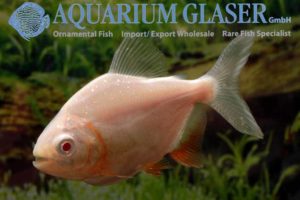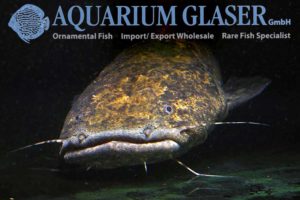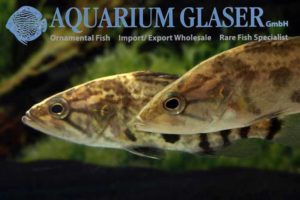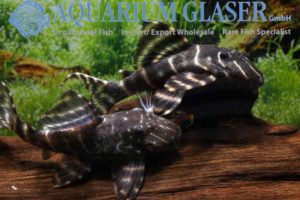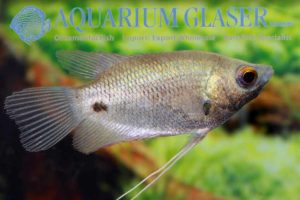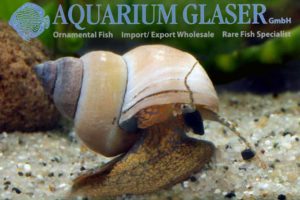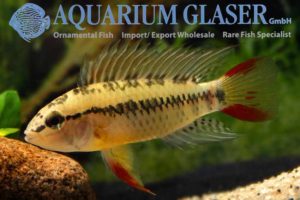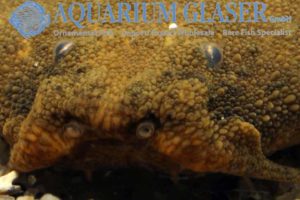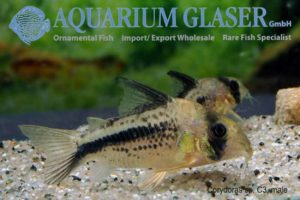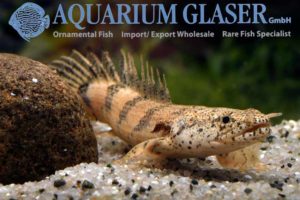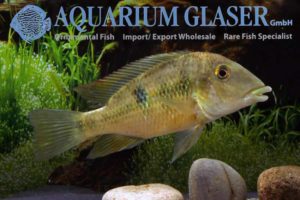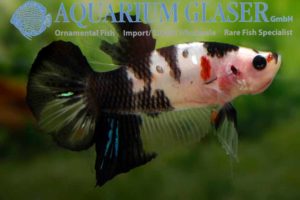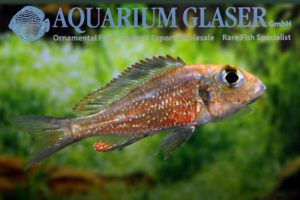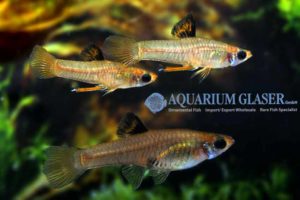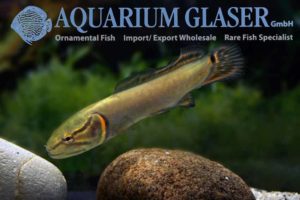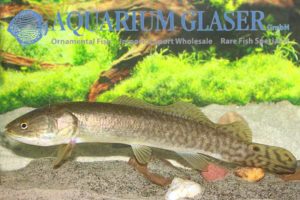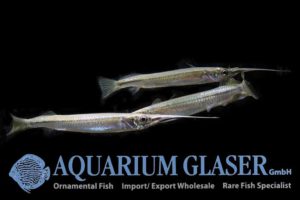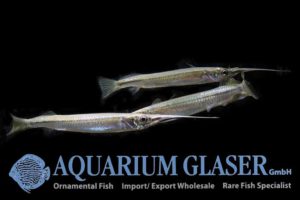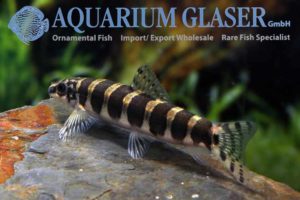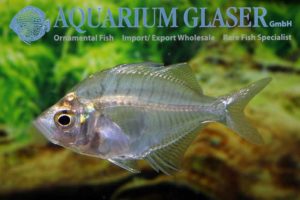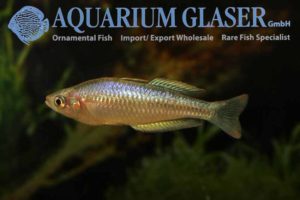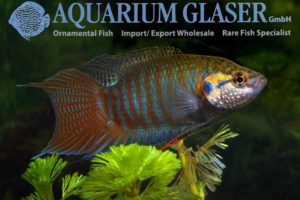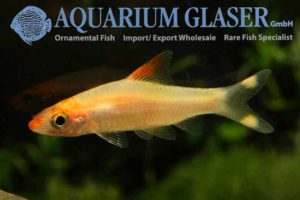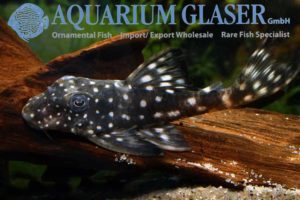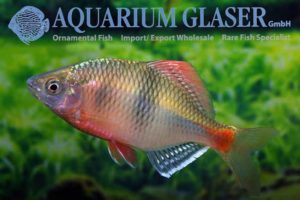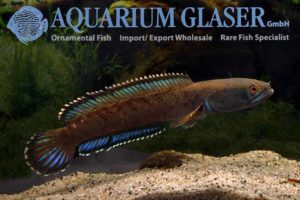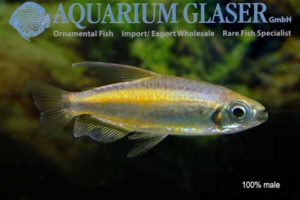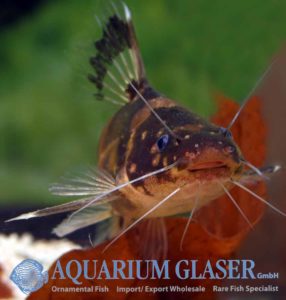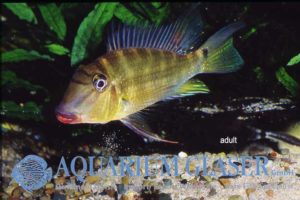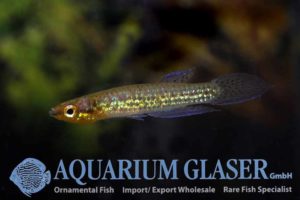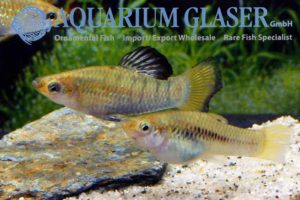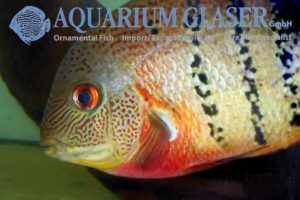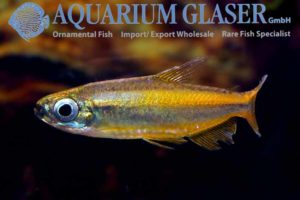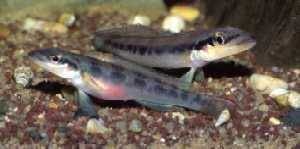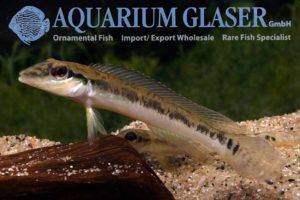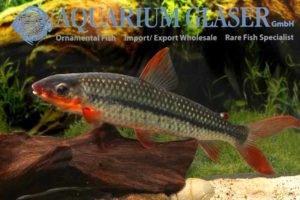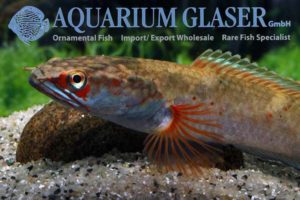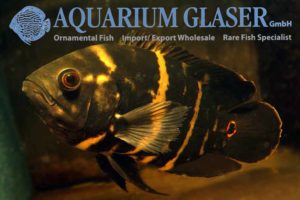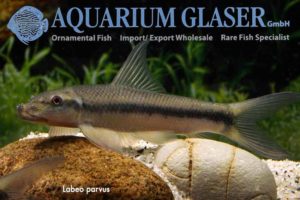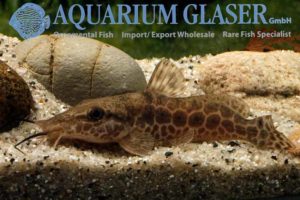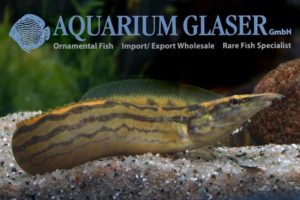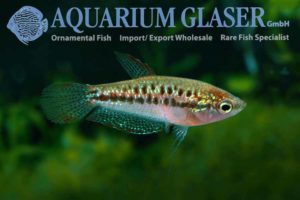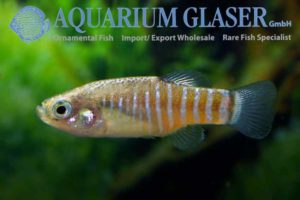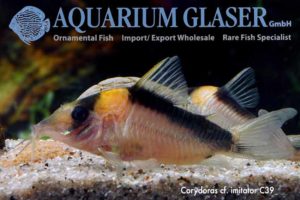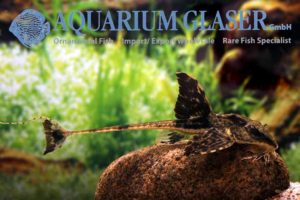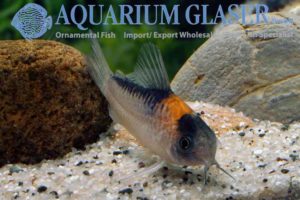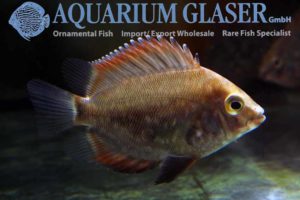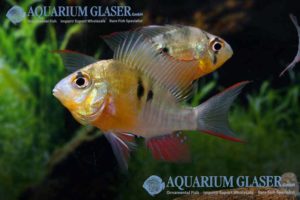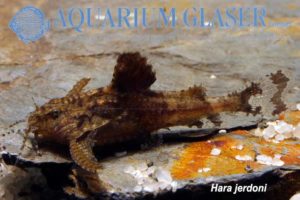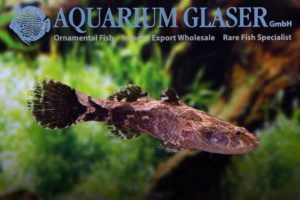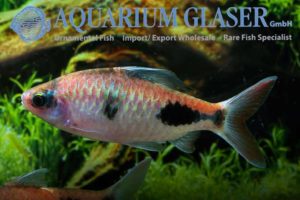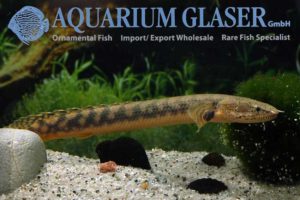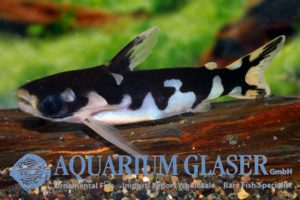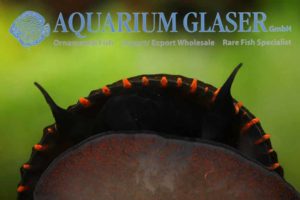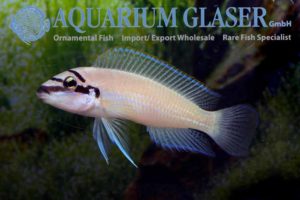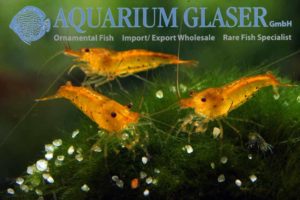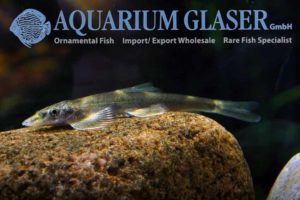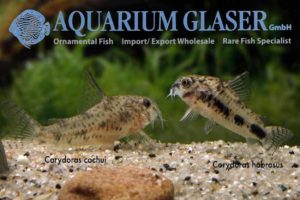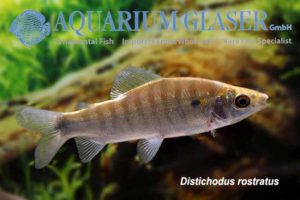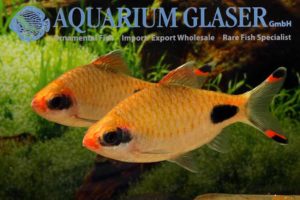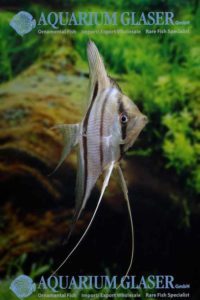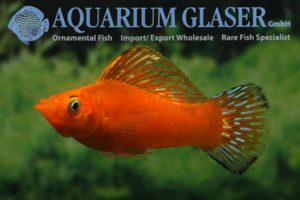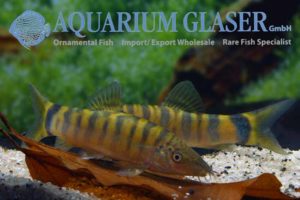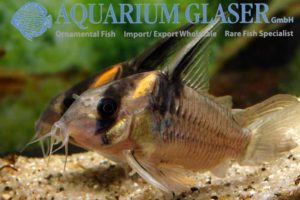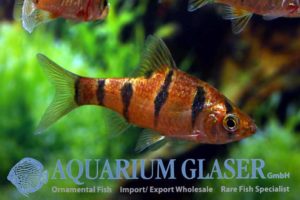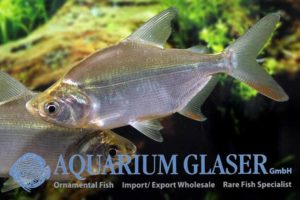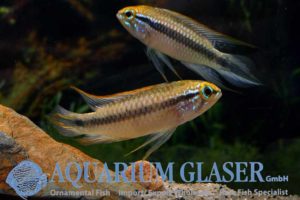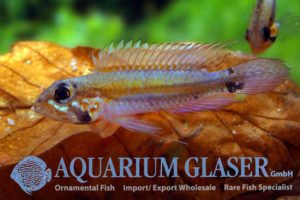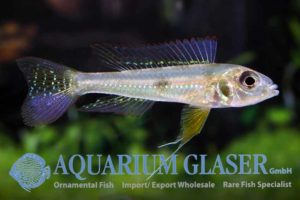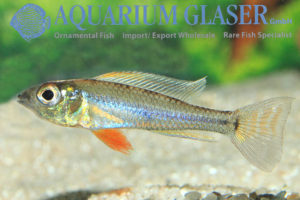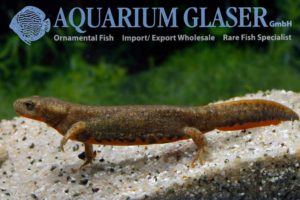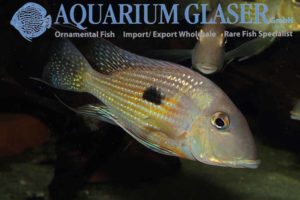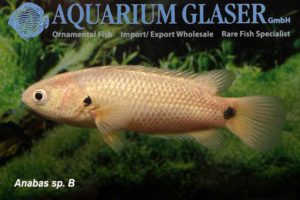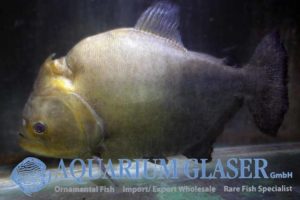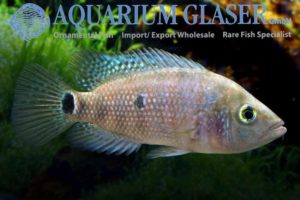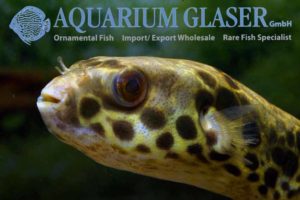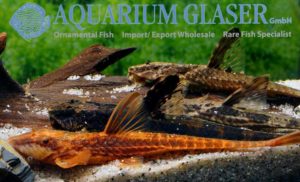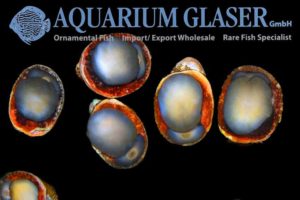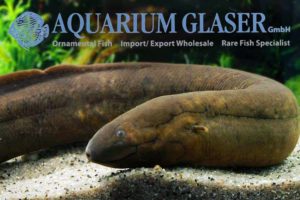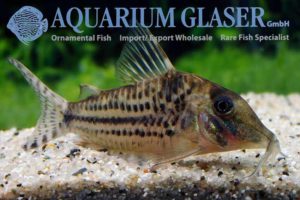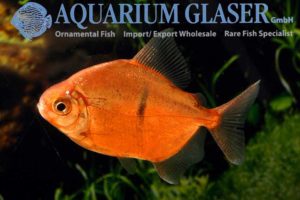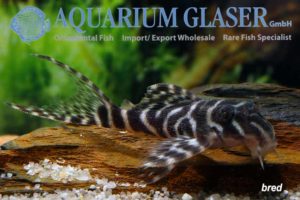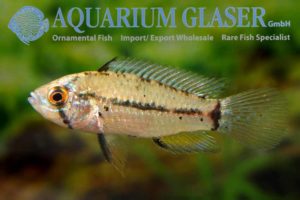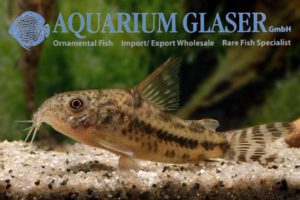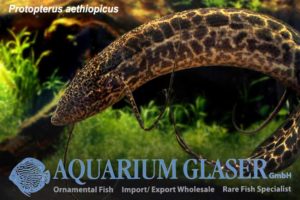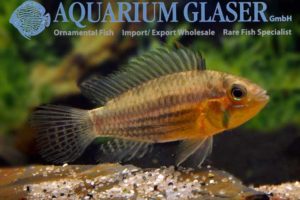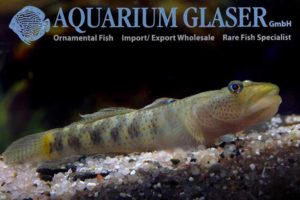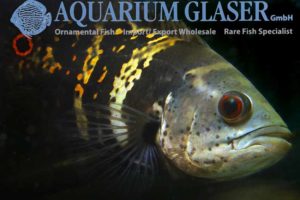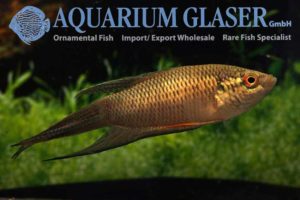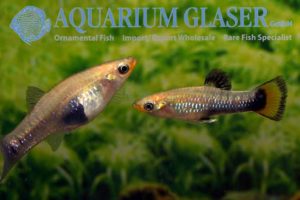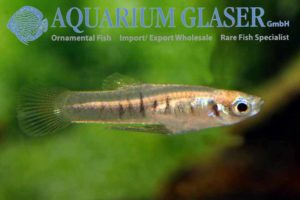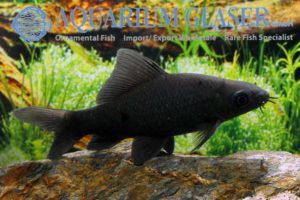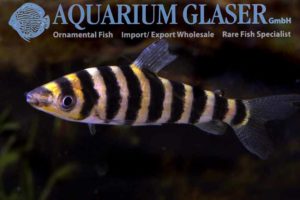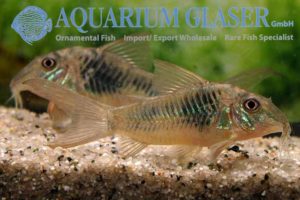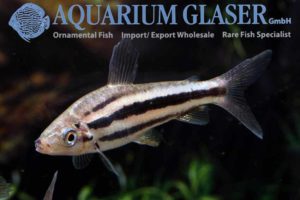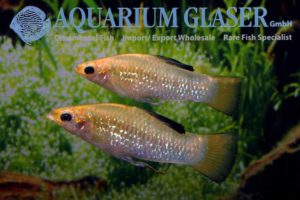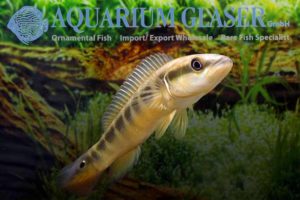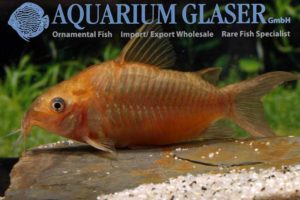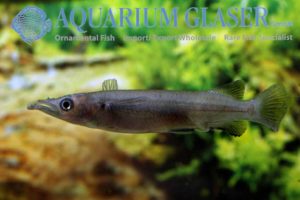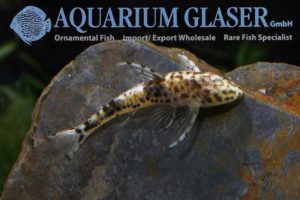Almost exactly four years ago we were able to import a pair of albinotic Pacus from Colombia (see http://www.aquariumglaser.de/en/archiv.php?news_id=470). At the time the import was quite spectacular. However, nowadays the fish are offered from southeast Asia already. These animals are by far more handy, because they are only 4-6 cm long, compared with the 16-20 […]
Fish Archive (2968)
-
-
Cephalosilurus apurensis
A face that can be loved only by a mother? Far from that! Among the fans of large, predatory catfish Cephalosilurus apurensis is a much sought after species! The fish attains a maximum length of about 30 cm and appears endemic in Venezuela (this means the distribution is restricted to that country). We were able […]
-
Coreoperca cf. liui
For the first time ever we obtained this interesting freshwater perch from southern China. The genera Coreoperca and Siniperca contain altogether 14 species. They are thought to be close relatives of the groupers (Serranidae), but are placed in a family on their own, the Sinipercidae. The fish were shipped under the name of Coreoperca kawamebari; […]
-
Panaqolus albivermis, L204
Currently we have all sizes of L204 in stock, among them fully grown specimens. They show impressively how different the individual pattern in loricariids can be. We have specimens with small spots, species-specificly banded animals and all thinkable intergrades. The photos were made from four fully grown specimens in our fishhouse, size-class 11-14 cm. Pictures […]
-
Osphronemus laticlavius
We received the very rare red finned giant gourami in two sizes, 5-7 cm (code 440923 on our stocklist) and 12-15 cm (code 440925). The species attains a similar size as the common giant gourami, eg 60 cm. O. laticlavius originates from Borneo. Fertile males develop a very prominent head structure and deep red fins […]
-
Filopaludina (Siamopaludina) martensi cambodjensis
For the first time ever we were able to import this pretty snail from Thailand. It is a typical viviparid snail that shares all the characters of the family: these animal breath via gills, not via lungs, and thus use the dissolved oxygen in the water for breathing, like fish do; there are males and […]
-
Apistogramma macmasteri Tame
It was back in 1996 when Uwe Werner presented in the Aqualog South American Cichlids II a dwarf cichlid under this name. The city and municipality of Tame are located in Colombia in the Arauca Department at the Rio Arauca. Here the unusual Apistogramma macmasteri have been collected. Sadly it became soon after lost for […]
-
Amaralia hypsiura
Banjo catfishes are subjects for lovers of calm fishes. One could also ay: for lovers of phlegmatic fishes. These creatures will not swim even an inch if it is not absolutely necessary. On the other hand they are really odd looking creatures. The strangest looking of this assemblage of strange-looking animals is without any doubt […]
-
Corydoras sp. C3
Shipments declared as “Corydoras deckeri” from Colombia are always subject of surprise. There is no scientifically described species C. deckeri, this name is pure fantasy. So sometimes Corydoras axelrodi, sometimes C. loxozonus, and sometimes the scientifically undescribed C. sp. C3 are shipped under that flag. This time we received the pretty C3. However, all three […]
-
Polypterus endlicherii bred
This large species – sexual maturity is reached at about 40 cm length, but the species can grow as big as 70 cm – originates from Africa. Her it has a fairly wide distribution, from the Nile to the Niger. But it is difficult to catch, so the fish were rather high in prize. Now […]
-
Geophagus pellegrini
Sadly we can offer this beautiful mouthbrooding cichlid from Colombia only very rarely; the last time we had it in stock was 5 years ago. Now we had the opportunity to import this animal. They originate from the Chocó region in Colombia, located in the West of the country. The main river of the Chocó […]
-
Betta splendens Pla Kat Koi
Once more we were able to import an assortment of this extraordinary and extremely rare sport f fighting fish. The term “pla kat” is used for the short finned fish. We present to you in this newsletter some specimens of the current import (among them an extremely rare albino), for more pictures and informations, please […]
-
Callochromis macrops
Is this a species of Geophagus from Lake Tanganyika? One can get these thoughts when seeing Callochromis macrops the first time. However, this mouthbrooding sand cichlids belong to the large Haplochromis-relationship. The ability to change the coloration is breathtaking in this species. The same individual that right now looked silvery or blotched will become in […]
-
Xenophallus umbratilis
Sadly this very attractive livebearer can be offered only very rarely. The species is also known as the “Golden Teddy” among hobbyists. Males become about 4 cm, females up to 6 cm long. Initially the species is native in Costa Rica, but the fish we have in stock now are German bred ones. For our […]
-
Amia calva
Finally – we tried many years without any success – we managed to import a good number of this “living fossil” from the USA. Once there was a time when relatives of this species lived allmost all over the World, even in Europe several species existed. These creatures were already existent when the dinosaurs walked […]
-
Amia calva
Four specimens – gorgeous animals, which are 15 – 20 cm long – of this “living fossil” reached us recently. Once there was a time when relatives of this species lived allmost all over the World, even in Europe several species existed. These creatures were already existent when the dinosaurs walked around. However, nowadays only […]
-
Zenarchopterus dunckeri
There are 20 valid species in the genus Zenarchopterus, all of them occuring along the Pacific coast of tropical Asia. The maximum length of Zenarchopterus is around 15 cm, only a few species are recorded to reach a greater length, most of them stay smaller. The species are very similar to each other and the […]
-
Zenarchopterus dunckeri
The wonderful, large halfbeaks of the genus Zenarchopterus are only very rarely offered, because the animals are very shy during the acclimatisation. When they panic they often hurt themselves seriously. So we are very proud that we were able to import successfully a small group of fully grown specimens of the species Zenarchopterus dunckeri from […]
-
Serpenticobitis cingulata
We received this beautiful loch from Thailand. The genus Serpenticobitis contains only three species, all described in 1997/98. They differ from each other only in pattern. The type species, S. octozona, has broad, dark vertical bands with only very narrow light interspaces. In S. zonata the interspaces are much broader; in both species he dark […]
-
Parambassis siamensis
Formerly this species of glass perch was the most common found in the trade. It has a very wide distribution through Thailand, Vietnam, Cambodia, and Laos. However, Parambassis siamensis was most often mis-identified and traded under the name “Chanda wolfi”. P. siamensis is very similar to the Indian species P. ranga. Both are distinguished by […]
-
Melanotaenia pygmaea
For the first time ever we obtained this charming rainbowfish from a breeder. The specific name “pygmaea” refers to a small body size. In fact our fish are full in coloration. They are currently about 4 cm long (total length). According to literature the maximum lengthin males is about 7 cm, whereas females always stay […]
-
Macropodus opercularis WILD
The Paradise fish was the first exotic species (leaving the goldfish aside) of ornamental fish that reached Europe. This was back in 1869. Wild collected specimens are hardly ever available. We now could import wild caughts of that fantastic aquarium fish from China via Hongkong. The black throat with white spots that is shown by […]
-
Sahyadria denisonii GOLD
In any species of fish that is bred in large numbers sooner or later sports appear. This now happened also in the gorgeous Indian Redline Torpedo Shark, Sahyadria denisonii. Besides “normal” bred ones Indonesian breeders now offer a golden sport of that fish. It is obvious that the individual fish differ a lot in the […]
-
L102, Hypancistrus inspector
Once more we could import the beautiful Snowball Pleco (Hypancistrus inspector, L102) from the Rio Negro in Brazil. The species can attain a maximum length of about 18-20 cm and is one of the largest species in Hypancistrus. However, our fish in stock are currently only 6-12 cm long. In the most current import we […]
-
Acheilognathus macropterus – Giant Bitterling
For the first time ever we obtained this splendid bitterling via Hongkong. The species is said to become more than 25 cm long and this would make it the largest species of bitterling at all! However, our fish are currently 6-8 cm long and in full colour, so maybe more than one species is involved, […]
-
Channa sp. True Blue
We could import this extreme beautiful species of snakehead in very small numbers from the north of India. The True Blue is obviously a close relative of C. stewartii; both attain a length of about 25 cm. The two photographed specimens have a quite different pattern. Most probably the smaller specimen is a female (it […]
-
Phenacogrammus aurantiacus II
Last week we presented to you our freshly imported Golden Congo Tetras (Phenacogrammus aurantiacus). The slight fin damages of the fish are as good as cured completely now. Many of our customers now ask for “safely” sexed specimens. All we can say to that is: of course large, dominant males are easy to recognize. But […]
-
Pseudomystus heokhuii
This pretty species of bumblebee catfish was discovered and scientifically described only in 2008. We could import the species now for the first time ever. P. heokhuii becomes about 6 cm long and is a very peaceful species of catfish. Despite the fact that Pseudomystus heokhuii inhabits extreme blackwater habitats in the wild, where the […]
-
Satanoperca rhynchitis
We received beautiful German bred specimens of this rare eartheater. Until the species has been described in 2012 under the name of Satanoperca rhynchitis it was known in the hobby as Satanoperca sp. “Red Lips”. The fish develop the pretty red lips only when adult, so we add a picture of an adult specimen to […]
-
Aphyoplatys duboisi
It has been many, many years ago since we were able to import this charming dwarf killi the last time. Currently the fish are about 1.5-2 cm long, maximum length reported for Aphyoplatys duboisi is only 2.5 cm. The fish have been collected in the surroundings of Brazzaville. Despite their very small size these fish […]
-
Limia Special
Poecilia (Limia) perugiae The Dominican Republic is the destination for millions of tourists each year. But it is only known by few people that also beautiful freshwater fish exist there. One of the prettiest of them is Poecilia perugiae. We can offer this beautiful livebearer on a quite regular basis, but have usually only few […]
-
Heros sp. Curare
For the first time ever we were able to import this splendid species of Heros. Reportedly the animals have been collected in the Rio Curare (name). However, we haven´t eard of a Rio Curare so far. We think the fish have been collected in the Rio Ventuari. The fish are extremely colorful; all other features […]
-
Phenacogrammus aurantiacus
Only yesterday reached us a phantastic import from the Congo that contained several top rarities from the surroundings of Brazzaville, for example Distichodus teugelsi, D. sp. Red Stripe, Aphyoplatys duboisi, and many catfishes. We will present all these species to you in the next weeks, but one small sensation should be shown here right now, […]
-
Teleocichla centrarchus
Teleocichla centrachus from Rio Xingu probably is the most imported Teleocichla. In addition, it is the type species of this kind. As the males have a maximum length of approx. 10cm, you can certainly still call them dwarf cichlids. The females, being mostly only 8cm maximum, are a little smaller and rather soon show a […]
-
Teleocichla centrarchus
Teleocichla are small cichlids from Brazil. They love comparatively strong current. The genus is a close relative of the pike cichlids (Crenicichla). The genus teleocichla has been discovered only late, in 1988; currently 18 different species are known, 10 of them are still undescribed scientifically. Genus type is T. centrachus; we can offer now once […]
-
Leporinus brunneus Ventuari
Once more we were able to import this beautiful, large tetra from Venezuela. The fish can reach a maximum size of 25-30 cm. It can be found in the basins of Orinoco river and the rio Negro. The coloration of the fish is quite variable, depending on the origin. The orange spot under the eye […]
-
Channa sp. Fire & Ice
Once more we can offer this small and colourful snakehead. The species attains a maximum length of only 12-15 cm. The fish belongs to an so far scientifically undescribed species which is found in the region of the Burmese-Thai border. The beautiful species belongs to the closer relationship of Channa gachua. Like this species, it […]
-
Astronotus cf. crassipinnis
There is no other genus of larger cichlids from South America that is so poorly understood as the oscars (Astronotus). Currently only two species are widely accepted, namely A. ocellatus and A. crassipinnis. However, there do exist a lot of more species as can be easily observed with the bare eye. We were able in […]
-
Labeo parvus and L. barbatus
Algae eaters from Africa? Hardly ever are such fish available in the trade, despite the fact that there does a high number of species exist. Currently we have two species of African Labeo in stock. There is no doubt that Labeo parvus is the better algae eater of the two. It looks astonishing similar to […]
-
Auchenoglanis wittei
Until recently only two species of Auchenoglanis were commonly accepted, namely A. biscutatus and A. occidentalis. This changed with the revision of Retzer (2010), who recognizes eight different species. In the Congo the genus is represented by Auchenoglanis wittei, which can be easily identified by the “reticulated giraffe”-pattern of the body. However, this is the […]
-
Mastacembelus tinwini
Sadly we can offer this beautiful species of spiny eel only very rarely. The species has been described scientifically quite recently. It is a close relative of the common spiny eel of Asia, Mastacembelus armatus. Like that species, M. tinwini reaches a length of about 40 cm. Other fish are ignored if they are large […]
-
Trichopsis pumila
The Sparkling Gourami (Trichopsis pumila) is one of the smallest species of anabantoid at all – and one of the prettiest! The charming and totally peaceful species attains a maximum length of only 3-4 cm and is perfectly suitable for an community tank with other tiny, peaceful species of fish. The tank should be well […]
-
Aphanius farsicus
Currently we have some fish in stock that are available every year only for a few weeks. These species are kept and bred by the hobbyists in a very special way, the “balcony aquarium hobby”. The species kept in that manner are specialized in water temperatures that differ clearly between day and night and they […]
-
Corydoras imitator and C39
Currently we receive imports of “Corydoras imitator” from the upper Rio Negro in Brazil. If one takes a close look on the fish it becomes obvious that hardly two specimens look really identical. Coloration is variable, as well is the shape of the body. Some fish, for sure, are unplanned by-catches, for example C. incolicana […]
-
Loricaria sp. Rio Atabapo
Finally we are able again to offer bred specimens of this Loricaria. It is the most beautiful species of the genus. Like all its relatives it is a mouthbrooding species. The males carry the egg-clusters along with them. For this they use the lower lip, which becomes much bigger during the breeding season, until the […]
-
Corydoras njisseni
Finally we were able to import again the smallest and cutest of all the different “orange blotch” Corydoras from the Rio Negro: Corydoras nijsseni. This fish is a close relative of C. elegans. The coloration, which is the same in Corydoras adolfoi, C. duplicareus, C. imitator, C. sp. C39, C. serratus, and serveral other species, […]
-
Uaru amphiacanthoides, bred
Only very view species of cichlid have such a drastic change of coloration during growing like Uaru amphiacanthoides. We can offer currently very nice bred ones. Uaru are close relatives of the discus. Like discus they wear the dorsal fin almost always spread. However, Uaru are mainly vegetarians. For more information and pictures of adult […]
-
Mikrogeophagus altispinosus
The Bolivian Ram, Mikrogeophagus altispinosus, is by far less popular than its well known cousin from Venezuela, the Common Ram (M. ramirezi). Maybe this is due to the fact that the Bolivian is traded almost exclusively as bred ones, because there are no commercial exports from the area where the species occurs naturally? But the […]
-
Hara jerdoni
Currently is the high season for the interesting moth cats (Hara). These catfish occur in India, Burma, and Thailand. The species are very difficult to tell apart, in many cases it is simply impossible in live animals. There are a few species that can be determined by a filament on the caudal fin, but most […]
-
Oxyeleotris marmorata
Most gobies live in the sea. And most gobies stay small, usually less than 10 cm. So Oxyeleotris marmorata, the Marbled Sleepergoby, is an exception in more than only one respect. The species is a giant among the gobies and becomes more than 50 cm long. And usually it lives in pure freshwater; only occasionally […]
-
Dawkinsia cf. exclamatio
We were able to import another splendid large barb from India. It belongs to the species Dawkinsia (formerly Puntius or Barbus) exclamatio or a closely related, scientifically still undescribed species. The fish are currently 8-9 cm long and are in breeding condition. Both sexes show now a red back, the males also develop “spawning pimples” […]
-
Polypterus retropinnis
After quite a long time we were able now to import again one of the smallest species of Polypterus, namely Polypterus retropinnis from the Congo. This bichir has been thought to represent an undescribed species for a while, but then it was found that it has been confused with the only recently described species Polypterus […]
-
Tatia musaica (= Cenromochlus orca)
We were able to import again a small number of the most attractive of all driftwood-catfishes: Tatia musaica, the ninja-tatia. This beautiful fish attains a maximum length of about 5-6 cm. Like all the driftwood catfishes this species also has an internal fertilization. The male´s anal fin is modified for that purpose, similar as it […]
-
Paludomus loricatus
Among the most unusual species of freshwater snail is the Red Spotted Bella Snail, Paludomus loricatus, from Sri Lanka. The eyes of this snail are very attractive coloured, brightly red-orange. Around the mantle are numerous folds of the same colour. We are informed on the biology of P. loricatus by Starmühlner (Starmühlner, F. (1974): The […]
-
Chalinochromis brichardi
This pretty cichlid from Lake Tanganyika is only very, very occasionally found in the trade. This is hard to understand. Despite the fact that the coloration is rather simple, the fish are quite conspicuous. Keeping and breeding can be compared with the closely related genus Julidochromis. Maximum size of Chalinochromis brichardi is about 12 cm. […]
-
Neocaridina sp. Golden Tiger
This is the latest star in our stocklist: are real pretty little creature! The animals are German bred ones, available in very limited numbers only! For our customers: the shrimps have code 485472 on our stocklist. Please note that we exclusively supply the wholesale trade. Text & photos: Frank Schäfer
-
Pseudohomaloptera sp – A new dwarfish hillstream loach from Vietnam
For the first time ever we obtained this hillstream loach from Vietnam. The determination is pretty tricky. All features visible in live fish (position of the dorsal fin, coloration, position of the anus) lead to the genus Pseudohomaloptera, which currently includes six described species: Pseudohomaloptera tatereganii (Popta 1905), P. sexmaculata (Fowler 1934), P. leonardi (Hora […]
-
Corydoras cochui and C. habrosus
These dwarf species of Corydoras have been confused quite a long time. Both species attain a maximum length of about 3 cm and a very cute, nice and lively aquarium fish. If one has the opportunity to see live specimens of both species together it may be hard to understand how they may be confused; […]
-
Distichodus rostratus, D. engycephalus and D. brevipinnis from Nigeria
Last week we received for the first time an unsusal shipment containing Distichodus unknown to us from Nigeria. The first determination was that they belonged to the species Distichodus rostratus. This species attains a maximum length of about 70 cm. We thought initially that all or fish would belong to the very same species, despite […]
-
Dawkinsia assimilis
In South India a group of barbs exists that was formerly placed either in Barbus or in Puntius and which is now placed in the only recently (2012) erected genus Dawkinsia. In Dawkinsia a phenomenon exists that aquarists are used to know for example from cichlids from Lake Malawi: every new collecting site reveals a […]
-
Pterophyllum scalare WILD Rio Xingu
We received very nice wild collected angels from the Rio Xingu in Brazil. The animals are “real” P. scalare with pointed snouts. They will most probably grow up to impressive, large fish. For our customers: the fish have code 699853 on our stocklist. Please note that we exclusively supply the wholesale trade. Available in limited […]
-
Poecilia velifera NEON ORANGE
We received this new sport of Molly from Southeast Asia. It was offered under the name of “Neon Orange”. The special feature of the new sport is the reflecting border of the scales on the back in front of the dorsal fin. This is more obvious in females than in males. In males. the reflecting […]
-
Yasuhikotakia sp New Cambodian Tiger
Formerly all the deep bodies loaches from Indochina were placed in the catch-all genus Botia. This generic name should be used now only for the Indian species, while the species from Laos, Thailand, Cambodia, and Vietnam are placed in Ambastia, Syncrossus, and Yasuhikotakia. We now were able to import for the first time ever a […]
-
Corydoras CW 45 Lessex
We can currently offer a very limited number of a new variety of the rare species CW 45. The fish was named “Lessex” by the exporter. We adopted that name, but we don´t know the meaning. CW 45 is a deep bodied species, similar to C. armatus. It differs from the latter by the bright […]
-
Desmopuntius hexazona wild
The banded barbs from Southeast Asia were always matters of interest, both of aquarists and scientists. The generic position of the species was unclear for quite a long time: they were placed in Barbus, Puntius, or Systomus. But t seems that the problems has been solved finally. The elongated species are now placed in the […]
-
Citharinus citharus
We recieved Moonfish, Citharinus citharus, from Nigeria. This tetra is only very rarely available. The large species can attain a maximum length of about 60 cm and 7 kg of weight. In its home countries, the moonfish is a much estimated food fish. But the species is also very interesting in respect of aquarium keeping. […]
-
Apistogramma agassizii Tefé II and A. geisleri
We received very nice wild ciollected specimens of this variety of A. agassizii. One must not confuse these fish with the variety known as “Tefé I” (see http://www.aquariumglaser.de/en/fish-archive/dwarfcichlids-en/Apistogramma_agassizii_Tefe_en/), which is distinguished from all other varieties of A. agassizii by the additional rows of zigzag-bands on the belly. The variety “Tefé II” is characterized by a […]
-
Apistogramma diplotaenia
This dwarf cichlid is one of the most unusual members of the large genus Apistogramma. The very slim animals have a pattern of two longitudinal stripes. This is unique among Apistogramma and makes A. diplotaenia unmistakable. Sadly this species is offered only very rarely. Currently we have both wild collected fish (see photos) and bred […]
-
Biotoecus opercularis
We received beautiful, fully grown wild collected Biotoecus opercularis from Brazil. Formerly these sandhill-builders (see http://www.aquariumglaser.de/en/fish-archive/dwarfcichlids-en/biotoecus-opercularis-3/) were said to be extremely demanding and difficult to keep. Our recent imports, however, are very, very stout and healthy animals! For our customers: the fish have code 634493 on our stocklist. Please note that we exclusively supply the […]
-
Biotoecus opercularis
This fish probably represents the most interesting species of dwarf cichlids from Amazonia. Currently we were able to import it once more. B.opercularis is for sure not demanded due to its coloration. As typical sand cichlids they do not have pop-art colours, but shining pastel shades. The same phenomenon can be found in the sand […]
-
Cynops cf. cyanurus
The fire bellied newts of the genus Cynops are perfect aquarium newts. Most specimens can be easily adapted for a life in water the whole year through. This makes feeding a lot easier, because on land newts are very secretive and feed only on live food, while in the water they also readily accept frozen […]
-
Geophagus sp. Aporema
Aquarium Glaser obtained in spring 2014 a boxed that contained a mixed group of Geophagus, which belonged to three different species. Among them were seven specimens that could not be applied to any known species of Geophagus so far. The fish were 7-8 cm long. Over the time the grew up to gorgeous, about 20 […]
-
Anabas
Fishes of the family Anabantidae are often referred to as Climbing perches. This name bases on a species of fish that is very famous among mankind, even in people who are not much interested in fish at all: Anabas testudineus. The species is known to walk over land at wet weather to search for new […]
-
Serrasalmus rhombeus – veteran
From time to time we import fully grown Black Piranhas from Peru (see http://www.aquariumglaser.de/en/news/3500gramm_35cm_Serrasalmus_rhombeus_BLACK_en/). Serrasalmus rhombeus (formerly also known as S. niger) is the biggest of all species of piranha. In contrast to the well known Red Piranha (Pygocentrus nattereri) the Black ones are solitary fish. The specimen we obtained now shows clearly how hard […]
-
Cichlasoma urophthalmus
We have a feeling that there is a trend back to the Central American cichlids, the big ones. Of course there are always fashions in the hobby. And of cozrse each generation of aquarists has to discover the magnificent diversity of aquarium fish on their own. Maybe this is the case currently in large Central […]
-
Tetraodon schoutedeni
Long time not seen! Formerly, in the 1960ies, Tetraodon schoutedeni was one of the most common species in the ornamental fish trade. Even breeding of this species proofed to be rather uncomplicated. But due to the civil wars in the Congo the situation changed drastically. Even nowadays the collectors prefer not to go to the […]
-
Rineloricaria lanceolata
Currently we obtain very nice Rineloricaria lanceolata from Paraguay. This species of whiptail catfish is very variable in respect of coloration. Almost all colours from deep dark brown (almost black) to a light clay-brown can be observed. It was back in the 1980ies that a brick-red sport of whiptail catfish appeared in the former GDR. […]
-
Neritina violacea, Red Lip Snail – new in stock
The snails of the genus Neritina have become very popular among aquarists. These snails are excellent algae eaters. They feed most algae from the glasses of the tank, because they prefer hard surfaces to live on. Another advantage of these snails is that they cannot breed under aquarium conditions, because the larvae develop in marine […]
-
Lepidosiren paradoxus
Only recently we introduced to you our lungfishes imported from the Congo (http://www.aquariumglaser.de/en/news/protocheirodon-pi/). Now we received the even rarer cousin: the South American Lungfish, Lepidosiren paradoxus, from Paraguay. There is only one species extant in South America, namely this living fossil. We usually import them as small young fish from Peru, the specimens we now […]
-
Corydoras vittatus
And here we have one more beautiful species of currently imported Corydoras. Corydoras vittatus – the specific name means “striped” – is one of the most variable species in respect of the individual pattern. The fish originates from Brazil. Formerly it was often regarded to be a subspecies of the also very variable species Corydoras […]
-
Myleus schomburgkii Red-Salmon
The Black-banded silver dollar, Myleus schomburgkii, is bred for quite a long time already in Southeast Asia. So it was a mere question of time when – after the “Lamax” (see http://www.aquariumglaser.de/en/news/Myleus_sp_LAMAX_III_en/) – additional artifical sports would appear in the market. Nevertheless the fish we now received from Singapore left us a bit speechless: we […]
-
Hypancistrus sp. L66 King Tiger Pleco
The King Tiger Pleco originates from the Rio Xingu in Brazil. The species belongs to the most popular plecos in the hobby. This fish attains a length of about 15 cm. Currently we can offer very nice German bred ones (4-5 cm long), which have a pretty and strongly contrasting black-and-white-pattern. Like in all species […]
-
Apistogrammoides pucallpaensis
Among the dwarfs this is the smallest: Apistogrammoides pucallpaensis. This species from Peru is one of the smallest species of cichlid at all. The maximum size is given in literature with 5 cm (males) and 4 cm (females). However, this must refer to very old aquarium specimens. Wild collected ones are mature and fully grown […]
-
Corydoras diphyes and Otocinclus mimulus
Corydoras diphyes and Otocinclus mimulus are available irregularly in Germany and have been recently described by Axenrot and Kullander (2003). They originate from the tributary of the Rio Monday, a river flowing into the Rio Parana in Paraguay. This species was known, for quite a long time, as Corydoras flaveolus in the hobby; this species, […]
-
Lungfishes from the Congo
After quite a long time we were able again to import juvenile lungfishes from the Congo. Currently the animals are 12-20 cm long. Three species of lungfish are known to occur in the Congo: Protopterus aethiopicus, P. annctens, and P. dolloi. At least two of them, namely P. aethiopicus and P. dolloi are represented in […]
-
Apistogramma cacatuoides wild
The Cockatoo Dwarf Cichlid is one of the most popular members of the genus Apistogramma and found in petshops all over the World. Almost exclusively bred specimens of very colourful sports are traded. These do not appear in the wild. However, “the” wild form of A. cacatuoides does not exist at all. Like so many […]
-
Rhinogobius maculafasciatus
Once more we are able to offer a species of freshwater goby that was not imported so far to Europe: Rhinogobius maculafasciatus. The species has been described scientifically only in 1996 from Taiwan; our specimens originate from Taiwan. So we are comparatively sure that the determination is correct. Determination of a Rhinogobius is not that […]
-
Astronotus zebra Tapajos
Again we were able to import a small number of this splendid wild form of the Oscar. For more informations, please see http://www.aquariumglaser.de/en/fish-archive/southamerican-cichlids-en/Large_wild_collected_Zebra_Oscars_arrived__en/ For our customers: the fish have code 633426 on our stocklist. Please note that we exclusively supply the wholesale trade. Available in very limited numbers only! Text & photos: Frank Schäfer
-
Macropodus spechti
The ancient homeland of the Black Paradise Fish (Macropodus spechti, formerly M. concolor) is Vietnam. We obtained now fully grown, wonderful specimens from there. The fish are most probably bred ones, but they differ clearly from the strain bred in Europe since the 1930ies. In direct comparison the new importations show a very attractive, brass […]
-
Poecilia (Limia) melanogaster
It happens only rarely that a wild form of livebearer is kept continuously over decades by hobbyists. This is understandable if one takes a look on the immense number of colourful sports that do exist from guppy, platy, molly & co.. So, if a wild form is able to compete with them it is without […]
-
Scolichthys iota
For the first time ever we are able to offer this tiny species of livebearer. Scolichthys iota has been discovered and described back in 1967 already, but has become never known alive to hobbyists until very recently. Our specimens are German bred. Males attain a maximum length of only 1.5 cm, females get almost double […]
-
Labeo chrysophekadion
The black shark is of course no shark at all, but a cyprinid or carp. It is a very large growing species, attaining almost a metre in length and 7 kg in weight. Like many other large carps it is a very much sought for food fish in Southeast Asia. So it is bred in […]
-
Unusual ornamental fish bred in Indonesia 3: Leporinus affinis
This is another, very attractive large tetra, which is currently offered as bred specimens from Indonesia. This Leporinus attains a maximum length of about 25 cm total length and stays a bit smaller than the otherwise very similar L. fasciatus, which reaches about 30 cm total length. The species needs a lot of plant material […]
-
Unusual ornamental fish bred in Indonesia 2: Corydoras septentrionalis
Corydoras septentrionalis is rather rare in the trade. It occurs in Venezuela and Colombia. The species is very similar to Corydoras ellisae from Paraguay. It differs from C. ellisae mainly due to the much longer snout and the colourless fin (with a spotted pattern in C. ellisae). We were a bit surprised to obtain that […]
-
Unusual ornamental fish bred in Indonesia 1: Leporinus arcus
There are many very successful breeders of ornamental fish in Indonesia. These people are able to breed even species that have proven to be unbreedable in hobbyists tanks for decades already. However, not all the species that are used as ornamental fish are only ornamental. Many species, for example Colossoma macropomum (Giant Pacu), the species […]
-
Poecilia (Limia) perugiae
The Dominican Republic is the destination for millions of tourists each year. But it is only known by few people that also beautiful freshwater fish exist there. One of the prettiest of them is Poecilia perugiae. We can offer this beautiful livebearer on a quite regular basis, but have usually only few specimens in stock. […]
-
Crenicichla semifasciata
Formerly the pike cichlids were splitted in two genera. Batrachops and Crenicichla. Batrachops were the rather blunt-headed species. Nowadays this classification is not accepted anymore and Batraochops seen only as a synonym of Crenicichla. However, hobbyists have not forgotten the old name… One of these blunt headed species is Crenicichla semifasciata from Paraguay. The attractive […]
-
Corydoras pantanalensis C5
This species is one of the largest of its genus: C. pantanalensis can reach a total length of more than 8 cm! Now we finally were able once more to import these splendid pieces of gold in small numbers. Besides the impressive size Corydoras pantanalensis is also very interesting because the males develop during the […]
-
Nomorhamphus celebensis
Most of halfbeaks of the genus Nomorhamphus originate from Sulawesi (formerly known as Celebes). Some species, like N. ebrardtii or N. rex, are traded usually as wild collected ones, others, among them N. liemi, are occasionally also available as bred ones. A species that occurs hardly ever in the trade is the Black Halfbeak, Nomorhamphus […]
-
Parotocinclus cf. variola
For the first time ever we were able to import this interesting dwarf suckermouth catfish. It originates from a only recently discovered region, namely the waterfalls of Cachoeira do el Dorado in the far northern parts of Brazil, almost at the border to Venezuela. This area has not been explored ichthyologically yet. Of all the […]
- « Previous Page
- 1
- …
- 13
- 14
- 15
- 16
- 17
- …
- 30
- Next Page »





